Founders Edition vs. Open-Air Video Card Coolers: The Definitive Analysis
Introduction
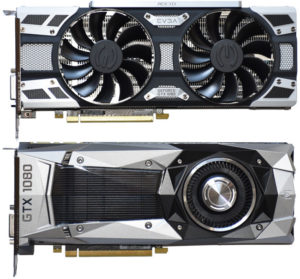 Back in early 2015, The Tech Buyer’s Guru published a unique look at video card cooler performance, comparing two very different versions of the top-of-the-line GeForce GTX 780 Ti 3GB video card to see how they compared in terms of thermal and acoustic performance. In that review, we determined that the reference “blower-style” Nvidia cooler, which had been around in one form or another for over a decade, provided consistent, proven performance, even if it wasn’t always the best overall solution. Well, a lot has changed in the intervening years, so we’re back at it to provide an even more comprehensive analysis.
Back in early 2015, The Tech Buyer’s Guru published a unique look at video card cooler performance, comparing two very different versions of the top-of-the-line GeForce GTX 780 Ti 3GB video card to see how they compared in terms of thermal and acoustic performance. In that review, we determined that the reference “blower-style” Nvidia cooler, which had been around in one form or another for over a decade, provided consistent, proven performance, even if it wasn’t always the best overall solution. Well, a lot has changed in the intervening years, so we’re back at it to provide an even more comprehensive analysis.
This time around, we’re going to be using the GTX 1080 GPU as our test chip. Released in May 2016, it’s still among the most powerful chips on the market. In fact, it’s almost twice as fast as the GTX 780 Ti 3GB released in late 2013, while using a lot less power, which is relevant when it comes to determining the effectiveness of a given cooling solution. To bring more attention to its efforts, Nvidia’s actually gave a name to its blower-style design, which it now calls the “Founders Edition.” While adhering to the same basic design as blower designs of the past, the shroud has been tweaked to give it an edgier look, and the internals have been upgraded to provide even better performance. As a counterpoint, we’ll be using a custom-designed “ACX” open-air cooler from one of Nvidia’s largest board partners, EVGA. Both will be strapped to our GPU of choice, the GTX 1080, which
Now, we want to make something very clear here: there are lots of custom designs out there, and enthusiasts could argue until the end of time about which is best, but we chose the EVGA model for two simple reasons: it carries no price premium, and it will fit anywhere the Founders Edition can fit. And that’s a critical point, because in our previous comparison article, we chose a big model from MSI that couldn’t be installed in one of our system, a compact ITX unit. This time around, you’re going to be seeing exactly how these two cards perform in a variety of scenarios, including on their own in both a well-cooled ATX case and a passively-cooled ITX case, as well as in dual-card SLI setups. Hold onto your hats, because we think all you cooler fans you might just be blown away! OK, OK, puns aside, we’ve designed this review to be as thorough as possible, which is why this time around, we’re calling it our “Definitive Analysis.” Frankly, we think we’re going to be able to put this issue to rest, so no, we’re not going to be running a follow-up to this article any time in the near future!
All right, with that all clear, we can return to our regularly-scheduled program!
Test Method
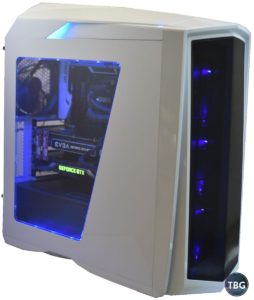 We used two different test beds to assess the capabilities of the two video card designs. Our ATX-based test system, which allowed testing in both single-card and dual-card (SLI) configurations, was as follows:
We used two different test beds to assess the capabilities of the two video card designs. Our ATX-based test system, which allowed testing in both single-card and dual-card (SLI) configurations, was as follows:
- CPU: Intel Core i7-6900K
- Motherboard: Asus X99-Pro/USB3.1
- RAM: Corsair 4x8GB Vengeance LPX DDR4-3200
- SSD #1: Samsung 950 Pro M.2 512GB
- SSD #2: Samsung 850 Evo 1TB
- Case: SilverStone Primera PM01
- Power Supply: EVGA Supernova 1000 PS
- CPU Cooler: Corsair Hydro H100i v2
- Operating System: Windows 10
This big tower system offers up tremendous cooling capability, courtesy of the SilverStone PM01’s three front-mounted 140mm intake fans and rear-mounted 140mm exhaust fan, along with the Corsair 240mm liquid CPU radiator with dual matching 120mm fans. It’s basically an optimal environment for a hot-running GPU, as it has tremendous airflow, and the CPU’s thermal envelope is almost entirely separate from the rest of the system. Cool air from the front fans hits the radiator, which is mounted in the upper-front corner of the case, meaning there’s very little consequence to filling your case with waste heat from video cards that aren’t “team players”, i.e., open-air models.
For our other test bed, we chose another SilverStone-based system, but it couldn’t be more different from the hulking PM01. The compact RVZ02 has been a mainstay in our DIY PC Buyer’s Guides, in part because it offers such a unique take on PC design. It’s actually one of the few compact ITX cases that can fit video cards larger than Nvidia’s reference design, although as we stated, our EVGA ACX model conforms to the same basic dimensions as the Founders Edition. Here are the system’s full specs:
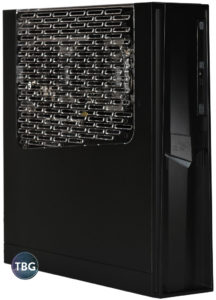
- CPU: Intel Core i7-6700K
- Motherboard: Asus Z170I Pro Gamer
- RAM: Corsair 2x8GB Vengeance LPX DDR4-3000
- Solid State Drive: Samsung 850 Evo 500GB
- Case: Silverstone Raven RVZ02B-W
- Power Supply: Silverstone SX500-LG
- Optical Drive: Samsung Internal Slim DVD Burner
- CPU Cooler: Scythe Big Shuriken 2 Rev. B
- Operating System: Windows 10
This system is notable in that the SilverStone RVZ02 case is so slim (at under 3.5″) that it offers no active cooling whatsoever. There isn’t a single fan mount in the chassis, so all cooling comes from the CPU fan, the power supply fan (which is essentially isolated from the rest of the system), and the GPU cooler. To help maintain thermal control, SilverStone wisely separated the two main heat generators into separate compartments of the case, divided by an internal wall. As we’ll see, however, heat can and does spill over when the going gets rough!
In terms of fan settings, we created a custom profile to provide the best opportunity for our cards to shine. We set them to run at 50% fan levels until they hit 80 °C, at which point they ramped up to 80%. When the GPUs hit 83 °C, the fan ramped up again to 100%. To be clear, we chose these points because they are “pain points” in the GPU’s thermal programming. While in the past GeForce-based cards would throttle once at a certain temperature (typically 70 °C), and then again when they hit a temperature limit (typically 83 °C), GPUs based on the Pascal design actually throttle a number of times on their way from idle to peak load. We’ve seen Nvidia’s GPU Boost drop clock speeds at 60 °C, 70 °C, 80 °C, and again at 83 °C, and while aftermarket software suites like MSI Afterburner appear to allow you to tweak the final throttle point slightly, we think most users would be surprised to learn that in the end, Pascal GPUs actually don’t listen very well to such commands. No matter what, these GPUs throttle at 83 °C, which means you definitely want to keep them below that level.
We used three GTX 1080 samples, as follows:
All three of our test cards ran at exactly the same clock rates (1607 MHz Base Core Clock, 10,000 MHz Memory Clock). Well, that’s the theory, at least. In reality, despite running equal clock settings on all our cards, they didn’t necessarily boost to the same levels. That will be clearly explained in detail in this article. By the way, as always, we purchase our video cards at retail – these are not cherry-picked press samples. We strive to avoid any sort of bias when covering competitive markets like video cards. If you support this type of review, please help support this site by using our product links the next time you’re ready for an upgrade.
To make things even tougher for the two tested coolers, we ran our GTX 1080 GPUs not just at reference settings, but also in a heavily-overclocked state. We settled on a stable overclock of +190MHz on the core, and +800MHz on the memory, which allowed our cards to run at around 1950MHz/10800MHz during our benchmark sessions. Note that you might see all sorts of wild claims about what the GTX 1080 GPU can hit (starting with Nvidia’s absurd boast that the Founders Edition could sustain 2114MHz), but in our findings, testing four retail-purchased GTX 1080 samples, not a single one could do that. In fact, our earliest GTX 1080 sample, purchased in July 2016, was a terrible overclocker, unable to maintain stability with anything more than a +163MHz/500MHz overclock, translating to around 1925MHz/10500MHz in game. We obviously left that sample out of this analysis entirely, but it serves as a stark reminder that there’s a big difference between the anonymous, unsubstantiated claims you’ll see on forums and what hardware can actually achieve when you start to look at aggregate, substantiated numbers.
To put these coolers to the test, we used a very intensive, but still realistic, GPU benchmark: the 3DMark Fire Strike 4K Ultra Stress Test. Unlike power viruses like FurMark, this test renders an actual game-like scene, and uses multiple assets within the GPU to maximize load in a balanced fashion. It’s not just hammering one element of a GPU to produce massive thermal spikes, it’s forcing the GPU to render a complex 4K scene using all the GPU has to offer. This stress test runs for approximately 15 minutes, and that’s critical to our tests, because it takes about that long for GPU temperatures to level out, meaning it gives you a very good sense of what a video card will sound like when you’re actually playing a game for an extended period, not after 30 seconds of a benchmark loop. In all, we ran the 3DMark Stress Test over a dozen times, which took around four hours in total, and that doesn’t count all the hardware changes, data tabulation, graphing, photography, and analysis that went into creating this article. So as you can probably imagine, this was most definitely a labor of love, but it’s the kind of thing we’re willing to put time into to come up with answers than no one else can give you. We hope you agree that our findings are indeed definitive.
All right, with that introduction out of the way, it’s time to get into the nitty-gritty of our results, starting with a review of installation!
Single-Card Performance Testing (ATX Case)
We begin our benchmarks we start with a single card in our big, well-cooled ATX case. This is the best-case scenario for any video card, but it’s best for open-air cards, as their waste heat is quickly diluted and exhausted out of the case. Below you can see the interior of this ATX setup, with a single GTX 1080 Founders Edition card installed.
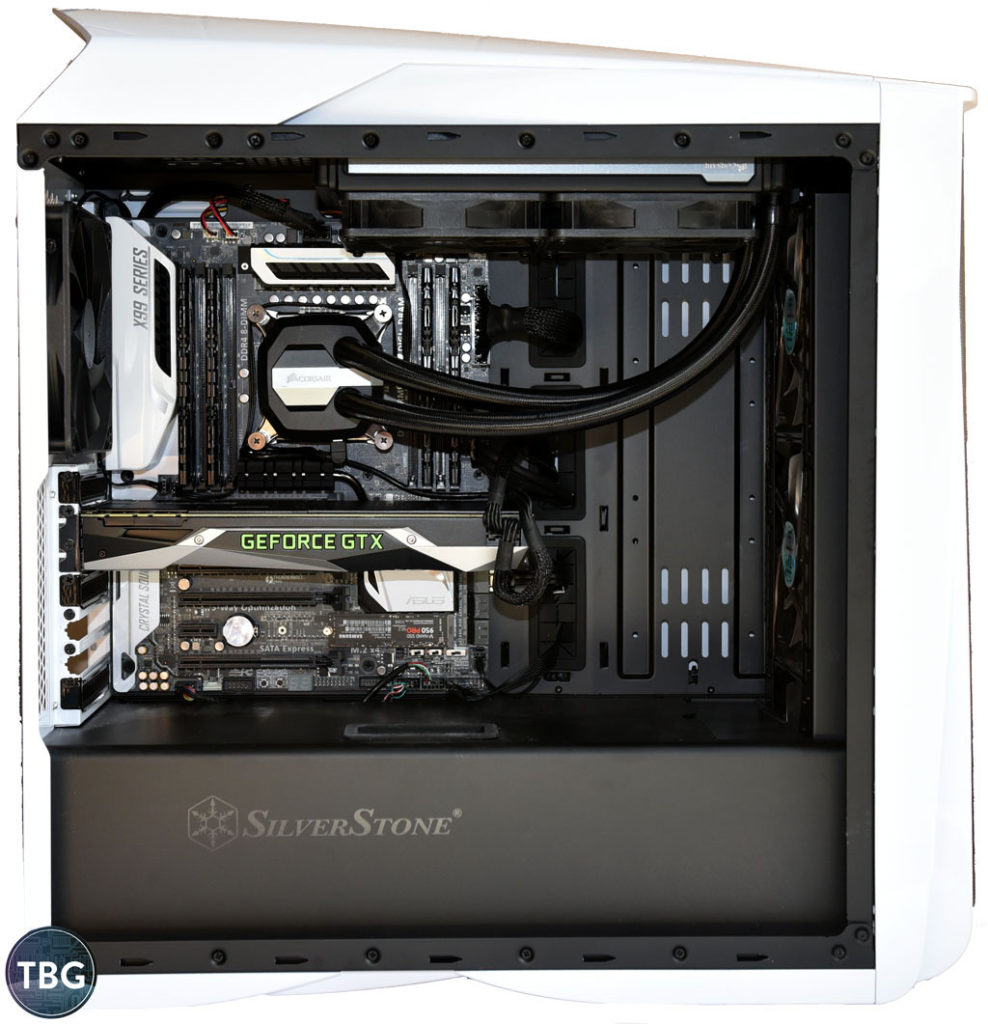
We aren’t going to be presenting idle numbers, as they just aren’t that interesting. The open-air card is always silent (and we mean that quite literally, as the fans shut off below 50 °C). The Founders Edition card does not have a zero-RPM mode, likely because its enclosed shroud could potentially cause unnecessarily-high thermal conditions at idle. It’s designed to push waste heat outside of the case, so it wouldn’t do a great job simply dissipating it without air movement.
And this all leads us to our first benchmark, running a 4K Stress Test with our GTX 1080 cards running at reference speeds. The first thing we want to point out, and this is really important, is that our cards are set to the exact same clock rates. Despite this fact, they do not run at the same clock rates, nor do they perform the same. This is due to the very real effect of thermal throttling, which is built into the Nvidia Pascal design. Nvidia became extremely aggressive with its Boost mode with the Pascal generation of GPUs, in part because the architecture of Pascal just wasn’t all that different from Maxwell that came before it, so to provide the performance gains that enthusiasts crave (and that justify high prices), Nvidia runs Pascal at the ragged edge of stability. That’s how we jumped from an average factory clock rate of 1200MHz in 2015 to 1750MHz just two years later. The smaller 16nm manufacturing node in use with Pascal is in part what allows this tremendous jump (and the nearly-linear 50% boost to performance over previous generation cards with the same basic layout), but Nvidia’s aggressive Boost is likely just as important, because it allows cards to hit very high clock rates when thermal conditions allow, along with serious down-clocking when they do not. We know people can get all up in arms about throttling, but it’s just something you’re going to have to live with in modern GPUs if you want maximum performance in short bursts.
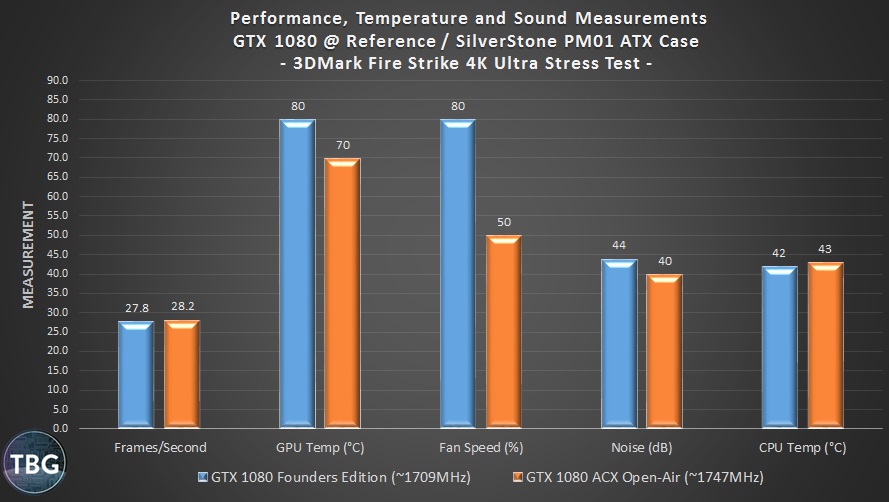
So, here we see that our open-air ACX card is superior nearly across the board. The only area where it falls slightly behind is in CPU temperature, where our massively-overclocked, water-cooled eight-core CPU runs just 1 °C, which in the end is completely meaningless. Under no circumstances would the Founders Edition card be the ideal pick in this situation. The ACX performs faster despite being set at the same clocks due to the Founders Edition hitting the 80 °C throttle point. And because its fans can run slower, it’s much quieter. In fact, we should note that it’s running at the noise floor of our test system – the CPU’s liquid cooler and the case’s four fans are actually what account for the 40 dB sound reading.
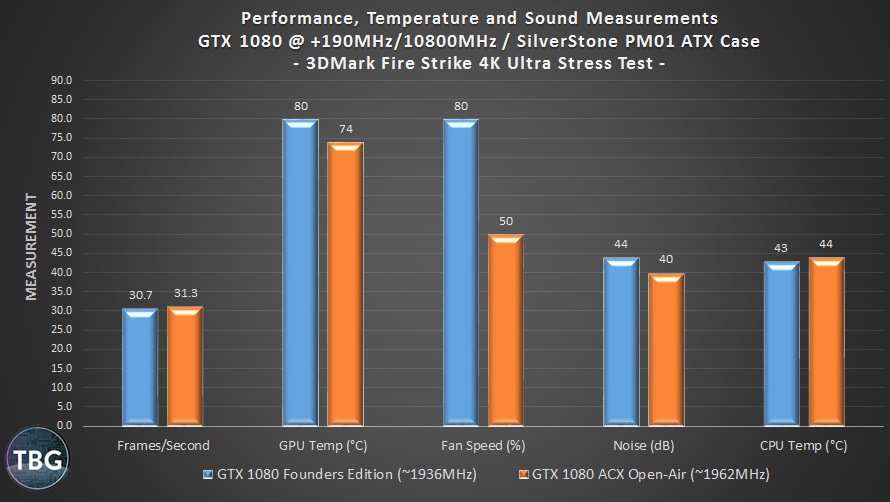
When we push our cards to a +190Mhz overclock (which amounts to around 12-13%), the situation barely changes. The cards are still running their fans at the same levels, and only the ACX card increases in temperature. Even so, it’s still well below the 80 °C throttle point that limits the performance of the Founders Edition. We should note that you can get a bit more performance out of this card by ramping its fans way up to keep the GPU under 70 °C, but things get loud in a hurry. One of the serious misconceptions about open-air cards is that they are universally quieter than the Founders Edition. This simply isn’t true. Two large fans running at the same rotational speeds as one small fan will in fact be much louder. Their saving grace is that they don’t need to run as fast, and users of such cards would be wise to take advantage of this fact unless they’re just chasing benchmarks. For long-term gaming, losing 10-20MHz of speed in exchange for a much quieter gaming experience seems like an obvious choice to us.
OK, the next step is to see if the ACX open-air model can keep its advantage when bottled up inside a compact ITX chassis!
Single-Card Performance Test (ITX Case)
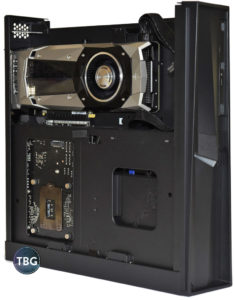 Here you can see a photo that illustrates the layout of our test system’s RVZ02 chassis. The video card resides in its own compartment, while the rest of the system lives below, separated by an internal wall. Note, however, that while these two compartments are nominally separate, plenty of exhaust heat from the video card area can directly reach the rear of the motherboard, which in turn can heat up the CPU pretty effectively. One reason we decided to use this case as our test platform is that it has no active cooling. That means the noise floor is essentially 0 dB (the CPU fan is nearly silent, and on the opposite side of the case from where our sound meter is placed), and the power supply has a zero RPM mode, so it’s silent as well (note, however, that the current shipping version of the SX500 PSU we used has actually dropped that functionality). In the end, all the noise we’ll be measuring is going to be from the video cards themselves.
Here you can see a photo that illustrates the layout of our test system’s RVZ02 chassis. The video card resides in its own compartment, while the rest of the system lives below, separated by an internal wall. Note, however, that while these two compartments are nominally separate, plenty of exhaust heat from the video card area can directly reach the rear of the motherboard, which in turn can heat up the CPU pretty effectively. One reason we decided to use this case as our test platform is that it has no active cooling. That means the noise floor is essentially 0 dB (the CPU fan is nearly silent, and on the opposite side of the case from where our sound meter is placed), and the power supply has a zero RPM mode, so it’s silent as well (note, however, that the current shipping version of the SX500 PSU we used has actually dropped that functionality). In the end, all the noise we’ll be measuring is going to be from the video cards themselves.
All of this is great for noise levels, but it also means there’s no way to get around a video card that isn’t up to the task of cooling itself. Furthermore, while it is vented, a lot of heat ends up getting recirculated if exhausted into the case, particularly because venting is minimal on top, where open-air cards direct most of their exhaust. We’ll see in a moment how that plays out in the benchmarks.
But first, we’ll provide a closeup shot of the two video card installations, side-by-side. This isn’t the smallest ITX case out there, and it can theoretically fit very large video cards. That being said, you’ll quickly run into issues with most current after-market cards, because they aren’t just longer, they’re also a lot taller. While your eye might trick you into thinking they can fit, you need to be able to drop them in from above to insert them into the PCIe riser slot, so you’ll lose the use of the mid-mounted VGA brace that makes sure the card doesn’t place too much strain on the slot. You’d also need to remove an internal brace in the corner of the case, which could cause problems with load-bearing if something is stacked on top of the case.
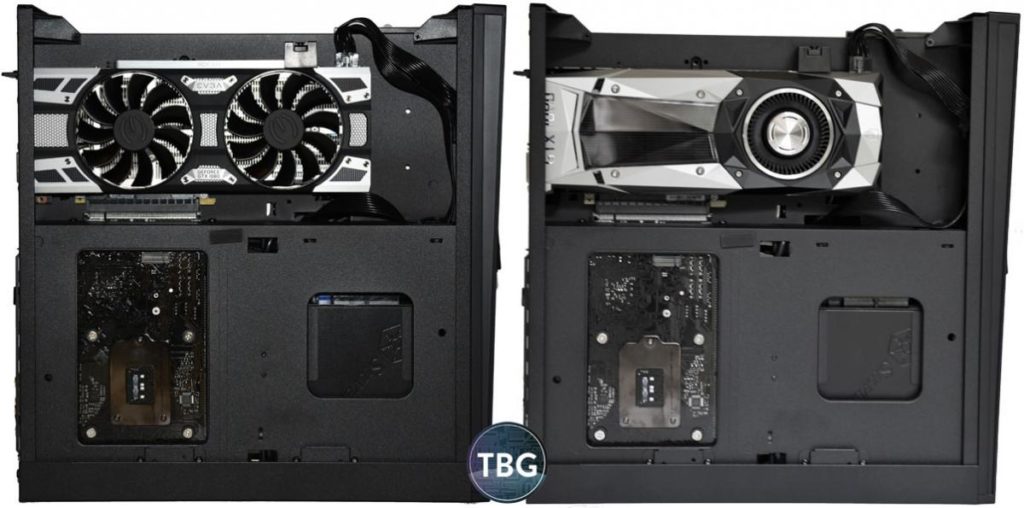
So how do the two video cards behave in this unusual environment? Let’s take a look:
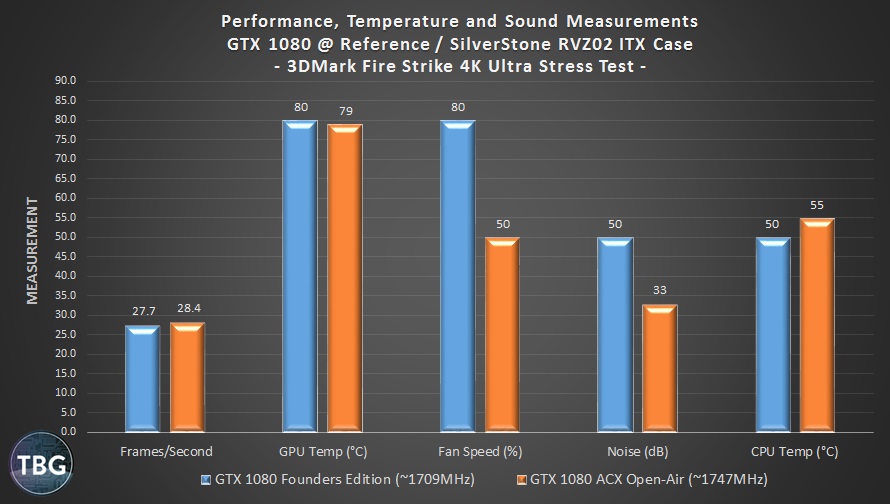
What do we have here? Again, the open-air ACX card is able to boost a bit higher at the same reference clock rates, translating to slightly better performance. But in other respects, things are quite different than they were in the ATX case. First, the open-air card is coming dangerously close to the 80 °C throttle point, which would render it no faster than the Founders Edition. On the flip side, the noise readings are massively different: 33dB vs. 50dB. And no, this isn’t a mistake. If you look back to the previous page, you’ll see the ACX measured at 40 dB, while the Founders Edition measured at 44dB. How could one now be much quieter and the other much louder in this test despite the same fan levels? It all comes down to the test setup. The ATX case we used had lots of noise-generating components in it. Our ITX case has none. Therefore, the 33 dB measurement, taken 6 inches from the video card fans, represents the noise generated by the ACX card, pure and simple. It’s the only noise-generating component in our entire test bed (nominal noise from the CPU fan isn’t picked up by the microphone due to being on the other side of the case). Our Founders Edition, on the other hand, has nothing to muffle its noise. Our sound meter is just six inches from its intake, whereas in the ATX case the card was buried deep inside a case, with the sound meter over a foot away. That makes all the difference in the world. In other words, put your ear up to Founders Edition cooler when it’s running at the 80% level, and you’re going to hear it loud and clear!
We think just about everyone would conclude that the open-air card was again superior based on the graph above, but what happens when we push our cards to their maximum overclocks? Does the ACX cooler still dominate?
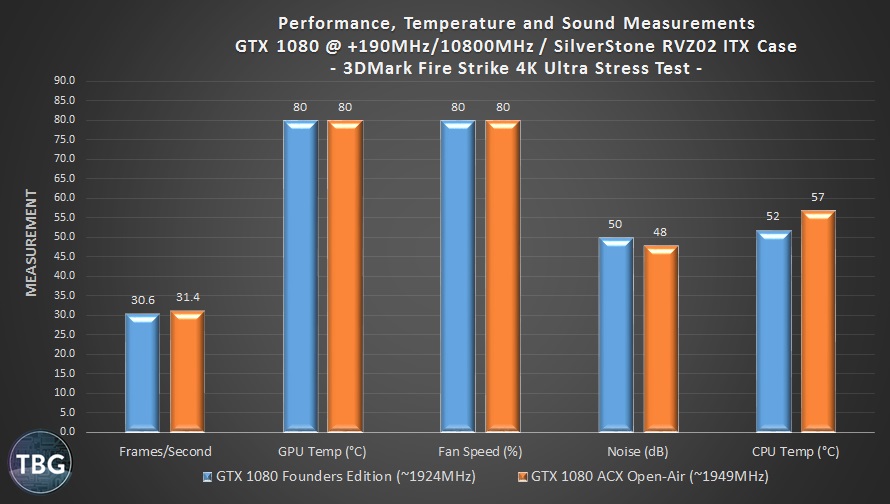
Uh, oh, what do we have here? The open-air EVGA ACX model can no longer stay below the 80 °C thermal throttle point. It’s still running a bit faster, but its clock rate advantage is now cut in half. The continued existence of a performance delta between the two cards may come down to the degree of temperature fluctuation and how that affects Nvidia’s boost algorithm. In this test, the ACX card jump around between 79 °C and 80 °C, which means it was flirting with higher speeds the whole time. The Founders Edition, on the other hand, was pretty well pegged at 80 °C. Remember how we said two big fans aren’t always quieter than a single small fan? You can see that in action here, as the ACX produces much more noise at an 80% fan level than it did at 50%, nearly catching up to the noise level of the Founders Edition. Perhaps just as importantly, the open-air ACX card is heating up the interior of our case substantially, meaning our CPU is now running 5 °C hotter, despite an ample cooler. That’s why builders of Small Form Factor systems really need to be careful about their choice of video cards, even if the cards themselves perform well enough in a cramped environment. We were running a 4K load, which means the bottleneck was most definitely the GPU. That made a lot of sense for testing the effectiveness of a GPU cooler, but if, for example, you had an application that loaded the CPU enough to have the bottleneck switch back and forth between the CPU and GPU, you could find the CPU running very hot in an ITX system.
Overall, we still think the open-air video card is superior, but just barely. For users looking for a low-risk, set-and-forget solution (which includes nearly all ITX System Integrators, by the way), the GTX 1080 Founders Edition is going to be the better pick.
SLI Testing
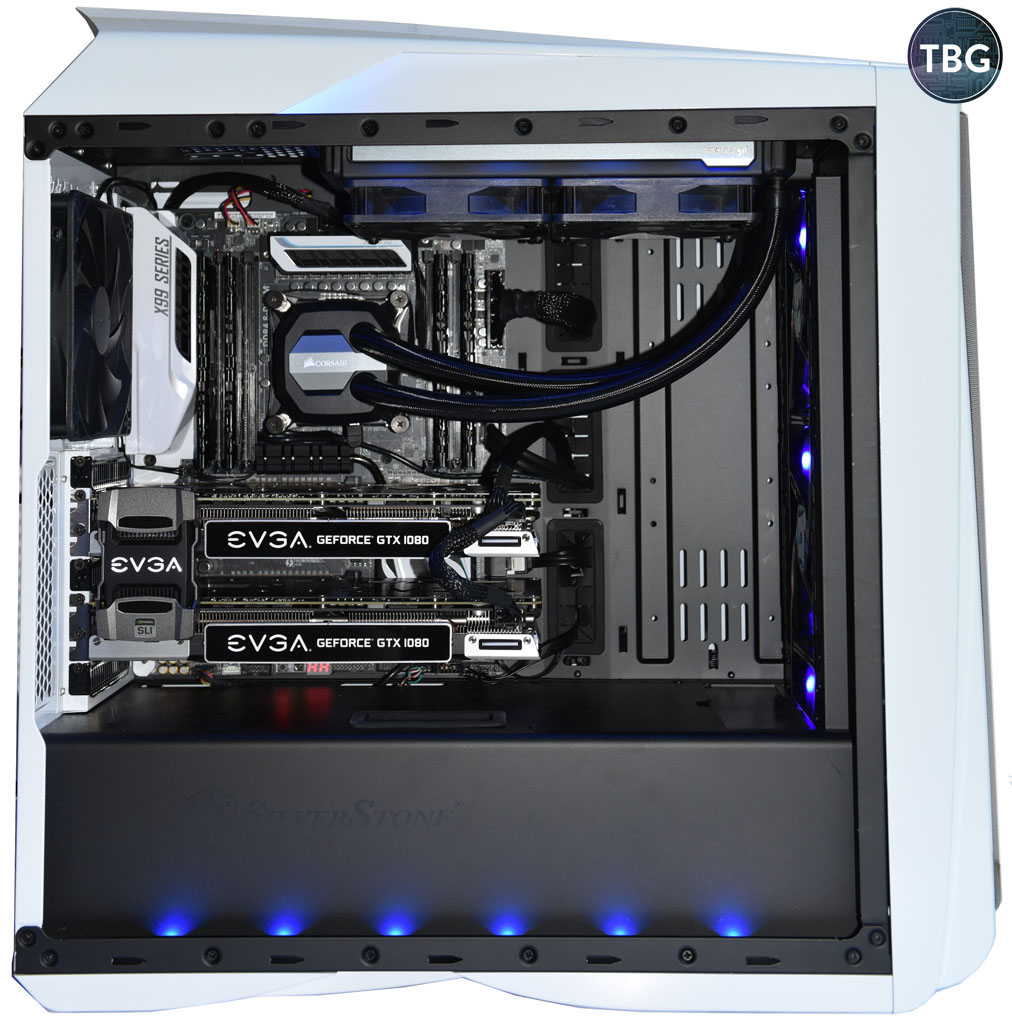
We’re going to turn back to our big ATX system for the last round of testing, but this time, we’re actually going to be challenging this well-cooled setup. That’s because we’re going to run two cards in SLI, which changes the thermal dynamics entirely. To add to the fun, we’re going to bring in our third GTX 1080 sample, so we can test three different SLI setups. First you’ll see our matched ACX cards, which is what most enthusiasts probably think will be the obvious choice for an SLI setup. Teamed up using our EVGA High-Bandwidth SLI Bridge that offers a serious boost to Pascal-based GPUs, they certainly look pretty impressive. If this were a beauty contest, the show would be over!
Alas, we’re hear to find the best-performing setup, not the best-looking setup, and that means we’re going to throw our Founders Edition card back into the mix. Below you can see the other two arrangements we tested. On the left, we have an ACX card on top, with a Founders Edition on the bottom, while on the right we have the opposite: a Founders Edition on top, and an ACX card on the bottom. Note that we didn’t test dual Founders Edition cards for two reasons: first, to avoid any hint of bias, we buy all our test video cards at retail, and buying another $500 GTX 1080 Founders Edition just for the sake of running one additional benchmark just didn’t work for us, sorry! But more importantly, we can deduce from the data we collected, which you’ll see in a moment, that dual Founders Edition cards would in fact be inferior to several of the other setups we tested.

First, we test our cards at reference settings. Recall that boost levels drop once the GPU hits 80 °C, and when running dual cards, that temperature is much more likely to be reached.
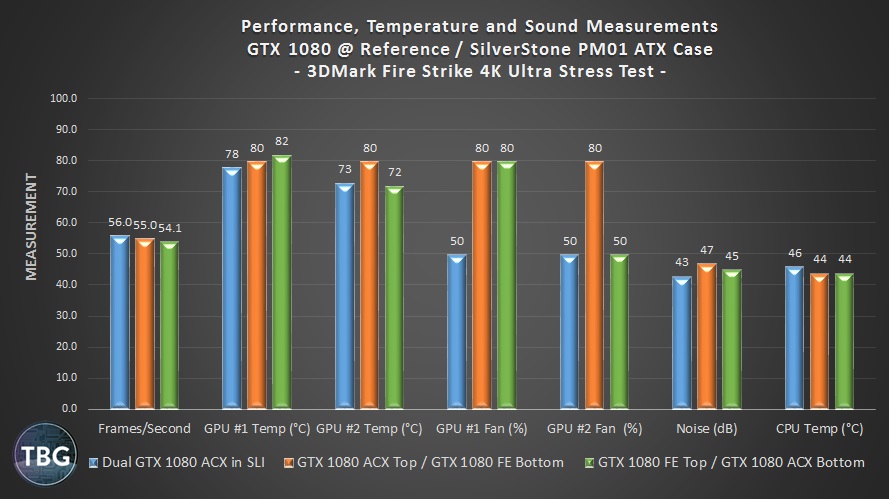
Well, no doubt about it, dual open-air ACX cards rule the roost here. Follow the blue bars in the graph above, and you’ll see that this setup leads to the lowest GPU temperatures and therefore the highest performance, despite the lowest fan speeds and lowest noise. The only drawback of this setup is that it heats up the CPU area enough to actually impact our high-powered liquid CPU cooler. A less-capable air-based model could potentially be overwhelmed given the amount of heat being pumped into the case. That’s why we always recommend liquid CPU coolers in dual GPU setups. It just takes the guesswork out of the equation.
We can deduce from these results that even if we’d tested dual Founders Edition cards in SLI, they wouldn’t have been all that impressive. The setup with the Founders Edition card in the top position and an open-air card below, which is represented by the green bars, performed quite a bit worse than dual open-air cards. There’s really no scenario we can think of where adding a second FE card in the lower position would be preferable. It could be better than an FE card on top and open-air card on the bottom, but it wouldn’t be better than the dual open-air setup we tested.
Frankly, we were a bit surprised that the combo of an open-air card on top and a Founders Edition card on the bottom, represented by the orange bars in the graph above, didn’t perform better in this test. Despite a scenario where it wasn’t inundated by lots of waste heat from the card below, the top-mounted ACX card ran hotter in this test than it did when we tested dual ACX cards. Let’s see if that holds true when we push the clockrates up…
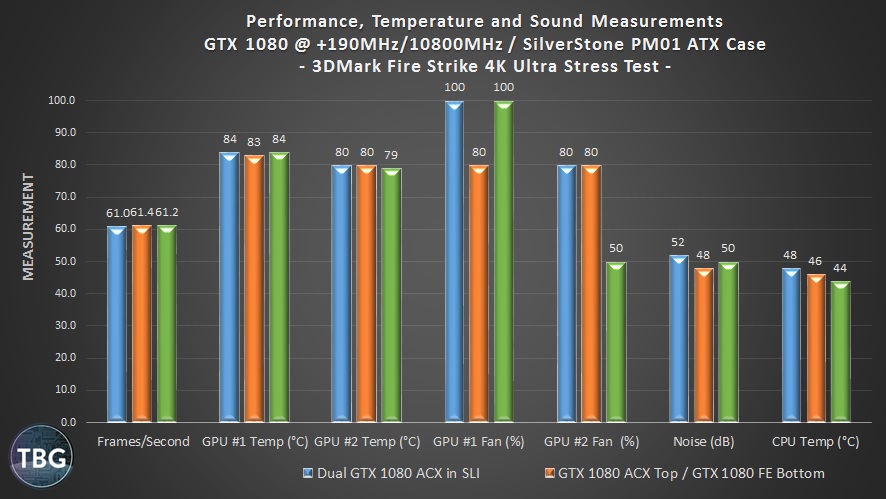
Now this is where things finally start to get interesting. Thus far, the Founders Edition hasn’t really proven its worth (or justified the higher price that Nvidia set for it!). But when pushed to the limit, our dual open-air ACX cards start to show their limits. In this test, the top card is now hitting 84 °C, which leads to a massive thermal throttle. This is despite the fact that its fan is running at 100%. The card is maxed out, but it’s not providing maximum performance. You can see that in the framerates for the dual ACX setup (again, follow the blue lines). It’s the slowest, loudest setup, and it’s not doing great things for our CPU either. In other words, choosing matched open-air ACX cards is actually the worst choice if you’re running dual overclocked GTX 1080 GPUs! Replacing the top card with a Founders Edition model doesn’t help matters much, as that card will also throttle significantly, while running its fan at 100%. The best solution is to have a Founders Edition card below, which allows both it and the ACX model above to level off at 80 °C using an 80% fan level, which offers the best combination of performance and noise levels.
Ultimately, the results are so tight here that one little change to the test setup could flip the outcome entirely. The use of a larger open-air card with dual 100mm fans or triple 80mm fans might put the open-air setup ahead, whereas a smaller ATX case with far less airflow (i.e., most ATX cases) would put even more of a hurt on the open-air cards. And remember, we’re using a liquid CPU cooler that really isolates the CPU to a great extent, but if you were running an air cooler, things would be totally different – not only would the CPU heatsink fill with hot air from the video cards, but it would also block the exit of exhaust air, causing more air to be trapped around the video cards. In other words, there are simply too many scenarios for us to test, but by presenting a number of test setups in this article, we think we’ve given you something to work with.
Conclusion
Overall, we think it’s pretty clear that the Nvidia Founders Edition cooler is competent, but not compelling. It’s a safe bet, and it’s the model almost every OEM uses, but for performance enthusiasts, it’s rarely going to be the best pick. That’s especially true with the GTX 1070 and GTX 1080, for which Nvidia charged a premium over aftermarket models to get a reference cooler. In the face of limited early supply, early adopters simply accepted the “tax,” and it certainly added to Nvidia’s bottom line, but it shouldn’t be used to gauge the value of the Founders Edition cooler today. Nearly any open-air model will be superior in terms of thermals, acoustics, and most importantly, performance, even when set to the same clockrates. That being said, in a few instances, we saw where an externally-exhausting model could provide benefits, namely in low-airflow ITX system, where the Founders Edition performed nearly as well while limiting impacts on the CPU, as well as in an overclocked SLI setup, where dual open-air cards simply choke on their own waste heat. In other words, pick the right tool for the right job!
We hope you’ve learned a thing or two about coolers in this article – we certainly did! If you’d like to build yourself a well-balanced, well-cooled PC, see our do-it-yourself PC Buyer’s Guides, updated monthly, and if you’re in the market for a video card upgrade, check out our Video Card Buyer’s Guide, updated quarterly.
